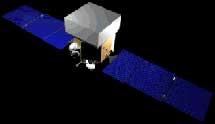
Handy Links
SLAC News Center
SLAC Today
- Subscribe
- Archives: Feb 2006-May 20, 2011
- Archives: May 23, 2011 and later
- Submit Feedback or Story Ideas
- About SLAC Today
SLAC News
Lab News
- Interactions
- Lightsources.org
- ILC NewsLine
- Int'l Science Grid This Week
- Fermilab Today
- Berkeley Lab News
- @brookhaven TODAY
- DOE Pulse
- CERN Courier
- DESY inForm
- US / LHC
SLAC Links
- Emergency
- Safety
- Policy Repository
- Site Entry Form

- Site Maps
- M & O Review
- Computing Status & Calendar
- SLAC Colloquium
- SLACspeak
- SLACspace
- SLAC Logo
- Café Menu
- Flea Market
- Web E-mail
- Marguerite Shuttle
- Discount Commuter Passes
-
Award Reporting Form
- SPIRES
- SciDoc
- Activity Groups
- Library
Stanford
Around the Bay
Secrets of the Gamma-ray Sky
 Gamma rays will reveal many secrets of the universe—but not until we know how to read their signals. Launching this week at SLAC is the GLAST Data Challenge 2 (DC2), a months-long “roleplay” of how physicists will analyze data coming from the Gamma-ray Large Area Space Telescope when it goes into orbit in 2007. DC2 follows an earlier, more rudimentary version of the challenge held from December 2003 to February 2004.
Gamma rays will reveal many secrets of the universe—but not until we know how to read their signals. Launching this week at SLAC is the GLAST Data Challenge 2 (DC2), a months-long “roleplay” of how physicists will analyze data coming from the Gamma-ray Large Area Space Telescope when it goes into orbit in 2007. DC2 follows an earlier, more rudimentary version of the challenge held from December 2003 to February 2004.
For the challenge, the organizing team members have secretly hidden a variety of astronomical objects in a computer-simulated mock universe, very similar to our own. They then calculated what that galactic center would look like to GLAST’s telescopes and created large data files to simulate the observations that will be beamed back to Earth from the satellite.
DC2 members take the enormous quantity of simulated data, representing 55 days’ worth of observation, and try to determine as much as possible about the mock universe. They will use the exercise to refine their analysis tools and techniques.
The analysts are given hints about what is out there, but are also required to find new objects in the simulated sky. For example, Data Challenge members must characterize at least six pulsars for which they are given some information, but are also asked to find some unknown ones that have been hidden. They also need to find and characterize supernovae remnants, galaxy clusters, dark matter clusters, active galactic nuclei, gamma-ray bursts, and more.
The DC2 will conclude with a meeting on May 16 - 18 to summarize what has been learned, and what else needs to be done to make use of the data coming from GLAST. A third data challenge will run from January to March 2007.
DC2 Workshop website
Read more about GLAST in
symmetry
—David Harris
SLAC Today, March 2, 2006